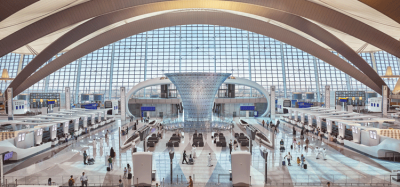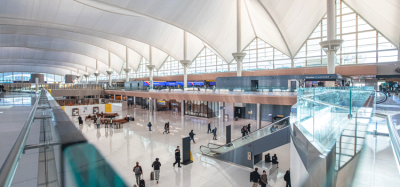Make or break: 2024 will be the year airport technology is overhauled
- Like
- Digg
- Del
- Tumblr
- VKontakte
- Buffer
- Love This
- Odnoklassniki
- Meneame
- Blogger
- Amazon
- Yahoo Mail
- Gmail
- AOL
- Newsvine
- HackerNews
- Evernote
- MySpace
- Mail.ru
- Viadeo
- Line
- Comments
- Yummly
- SMS
- Viber
- Telegram
- Subscribe
- Skype
- Facebook Messenger
- Kakao
- LiveJournal
- Yammer
- Edgar
- Fintel
- Mix
- Instapaper
- Copy Link
Posted: 3 April 2024 | William Muller | No comments yet
For International Airport Review, William Muller, Vice President of Seoul Robotics, discussed which emerging technologies will see a surge in use at airports in 2024 and how they will revolutionise airport operations.


William Muller, Vice President of Seoul Robotics, discussed which emerging technologies will see a surge in use at airports in 2024.
2024 is poised to be a huge year for travel. With a record-breaking 4.7 billion passengers estimated globally, airports are under increasing pressure to meet passengers’ expectations. Research published by IATA reveals that passengers’ top priority for post-pandemic travel is convenience; this comes after 2023’s summer travel season was marred by long security queues, flight delays or cancellations, and poor baggage management. However, in the wake of post-pandemic ‘revenge travel’ surges, airports are grappling with soaring consumer demand amid labour shortages and escalating costs, making traveller expectations more difficult to meet than ever before.
Airports are complex operations
Airports are hindered by outdated core systems and fragmented operations, with disparate technologies operating independently and communication chains faltering due to the lack of real-time data collection and sharing. This has created immense difficulties for operations, logistics, and staffing, threatening airports’ abilities to meet the growing demand for travel.
3D data can be collected at each stage of the travel journey and communicated between departments as distinct operations become connected “
With the growth of niche sectors like sports tourism expected to grow at a rate of 17.5% between 2023-2030, and upcoming global events like the Paris Olympics, airports will be stretched to their limits. As a result, there’s an urgent need to invest in innovative new technologies to allow airports to handle large traveller volumes and function with greater efficiency.
Data sharing and IoT
Though a lot of airport tech research focuses on biometric developments like digital passports, arguably the most important technological focus for airports going forward will be to streamline the collection and sharing of information across all departments using advanced internet of things (IoT) technologies. The information collected can form a centralised system to connect, streamline, and refine operations, and as a result also address rising costs and issues stemming from labour shortages.
For environments as large as airports, there is an inevitable disconnect between departments that occurs due to the sheer scale of operations, vast amounts of data, and myriad moving pieces. With individual systems siloed and managed by countless organisations and departments, airports are incredibly decentralised. This lack of cohesion creates breakdowns in communication, leading to inefficient logistics and accumulating lag times that cause ripple effects across entire airport ecosystems.
For travellers, airports are synonymous with queues. Despite advancements like online check-ins and automated kiosks that attempt to accelerate the process, the promised efficiency of these solutions especially falters when travellers encounter issues requiring human intervention, such as overweight baggage. This leads to further delays in the passenger journey, a result of chronic understaffing and the disconnected nature of the travel process. The limited scope of current solutions, which focus on separate functions rather than the bigger picture, fails to make a significant impact on improving traveller experiences and operational efficiency.
Optimisation of resources
The continued growth and success of airports hinges on efficient and reliable analysis and optimisation of resources. Accurate data that is regularly updated and shared between departments in a timely manner is essential to this process. Finding data that is collectable and valuable to multiple departments can be challenging, however emerging technologies like 3D perception are demonstrating that it is possible. When paired with IoT networks they can consolidate and make airports increasingly connected, enabling greater automation across all operations.
Digital replicas and digital twins
3D data can be collected at each stage of the travel journey and communicated between departments as distinct operations become connected. When leveraging other emerging technologies like AI, it can also be used to power digital twins that collect the most advanced environmental insights for a whole new dimension of spatial information. With 3D data from terminals, passenger traffic flow can be recorded and analysed to better track, understand, and predict behaviour, a valuable resource that can be shared and leveraged between departments to enhance planning, staffing, and ultimately the traveller’s journey.
Arguably the most important technological focus for airports going forward will be to streamline the collection and sharing of information across all departments using advanced internet of things (IoT) technologies “
For example, if real-time data shows a backlog of vehicles approaching a terminal, operations teams can redirect staff to the appropriate posts to manage incoming passenger traffic. The same process can also be applied to improve queue efficiency in all other areas, with data informing the deployment of additional personnel or the opening or closing of check-in desks, immigration counters, and security lines based on crowd data.
Digital replicas also provide advanced spatial understanding through pattern recognition and predictive analytics. Insights into heavily trafficked commercial and service areas can be used to inform various cleaning and maintenance schedules to optimise staffing levels around fluctuating traveller volumes to avoid worker redundancies or critical shortages. This data also enables informed decision making around airport designs and layouts, from redesigning spaces to guide efficient foot traffic flow and minimise crowding, to rearranging product and employee placement in duty free to streamline shopping and improve the customer experience.
Data sharing allows for easier collaboration across departments as internal communication networks are expanded. This will allow airports to not only improve day-to-day management, but also better handle seasonal and event-based surges, which have been a perpetual struggle, as evidenced by annual disruptions and delays during the summer season, particularly in Europe, where labour shortages have exacerbated operational challenges.
This year
In 2024 and beyond, the success of airports will rest on their ability to become increasingly connected across all facets of operation. The primary manner of which will likely be using extensive, converged networks of IoT technologies that connect all distinct airport functions. The consolidation of airport-wide data into a unified central network will greatly enhance proactive management, improving the experience for travellers and employees alike by using data to streamline historically time-consuming and labour-intensive processes. By implementing integrated insights throughout various operations and workflows, a deeper understanding of the systems within airports is achieved, fostering seamless collaboration across the board.
Liked this article? Share with your colleagues and subscribe to our magazine and newsletters here.


CREDIT: SEOUL ROBOTICS
About the author
William Muller is the Vice President at Seoul Robotics, where he works with external clients to effectively utilise the company’s proprietary 3D perception software for numerous business functions. Since joining the company in 2020, William has grown its strategic partnerships across a range of industries, including aviation, transportation, security, and smart cities.
Before Seoul Robotics, William supported business development for Cepton and Quanergy, leading Quanergy’s expansion into the security industry. Prior to that, William spent over 15 years working in security, including extensive experience installing wireless infrastructure and security systems globally and bringing new technology solutions to market.

















